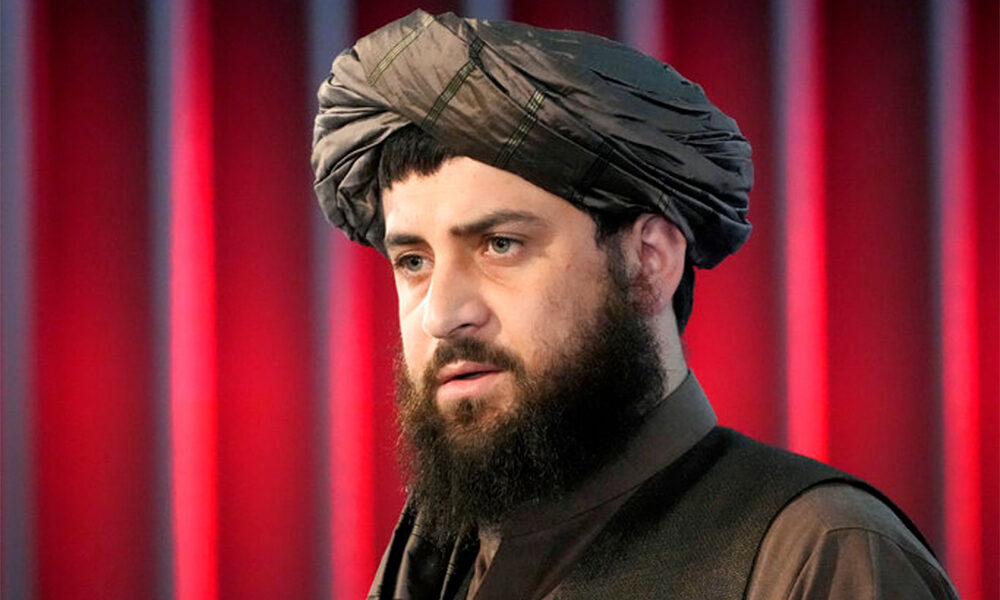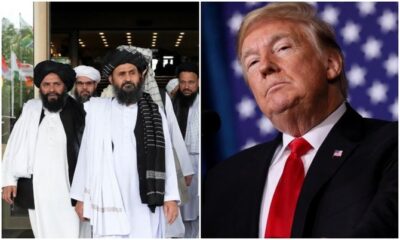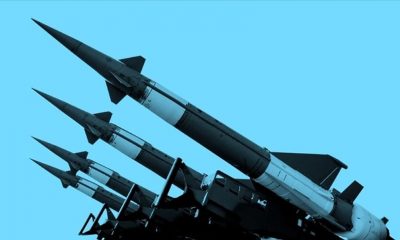Asia
Afghan Taliban warns Pakistan against any attack

It has been crystal clear that Pakistan has been the Afghan Taliban’s key foreign sponsors for decades. Relations between them were indestructible. Some Taliban officials also called Pakistan their second home. They were like iron-brothers, and the previous government had always complained about their relations and accused Pakistan for harboring Taliban leadership for the past 20 years.
But since the Taliban seized power in August 2021, its ties with Islamabad have deteriorated amid deadly border clashes and some other issues, especially disagreement over Tehrik-i-Taliban Pakistan, TTP.
Initially Taliban wanted to play a mediator role between Pakistan and TTP and they agreed for a ceasefire but last month, it came to an end and TTP intensified their attacks.
Taliban had earlier also said that Islamabad is permitting its air space to be used by US drones to strike targets in Afghanistan. In return, Pakistan has accused the Taliban of harboring terrorists.
What we get from this discrepancy is that the two long standing alliances, which dates back to the emergence of Taliban in 1999s, are coming under unprecedented strain due to divergence in their interests.
When attacks were intensified in Pakistan, the officials directly accused Afghan Taliban for harboring TTP members, and when border clashes happened, Pakistani officials called on Taliban to strengthen border security, dubbed it as failure. Pakistan had warned to take military action against terrorists in Afghanistan if needed.
Pakistan to attack TTP in Afghanistan soil
The Interior Minister of Pakistan, Rana Sanaullah said that it is the right of Islamabad to act against insurgents’ hideouts “in Afghanistan” if its nation is threatened by such groups.
In an interview with Express News, Sanaullah said Islamabad may attack the TTP hideouts in Afghanistan if Kabul does not take action to dismantle them.
“When these problems arise, we first ask Afghanistan, our Islamic brother nation, to eliminate these hideouts and handover these individuals to us, but if that doesn’t happen, what you mentioned is possible,” Sanaullah said.
Sanaullah did not go further, but since the Taliban took over Afghanistan in 2021, Pakistan has witnessed a sharp rise in terrorism incidents mostly in the Khyber Pakhtunkhwa and Balochistan.
According to the statistics by an Islamabad-based think tank Pakistan Institute for Conflict and Security Studies (PICSS), compared to November in December 2022 the number of militant attacks increased by 44%, and majority of them were claimed by TTP.
In December 2022, the militants carried out 49 attacks, in which 56 people lost their lives, including 32 security forces personnel. 17 civilians were also killed.
In August 2022, Abdul Wali, aka Omar Khalid Khorasani, top commander of TTP, who was allegedly behind some of the deadliest attacks in recent years, was killed in a roadside bomb in eastern Afghanistan. Three of his accomplices were also killed in the incident. TTP vowed revenge.
Taliban says ready to defend from Afghanistan
Reacting to Sanaullah’s statement to attack TTP on Afghanistan soil, the Taliban government said it would not let anyone attack Islamic Emirate.
Taliban defense ministry in a statement said, “Afghanistan is not without its owner, as always, we are ready to defend the territorial integrity and independence of our homeland, and it is mentionable we have a better experience than anyone in defending and protecting our country.”
The Taliban also called Sanaullah’s statement “provocative and baseless”, and requested that any concerns and problems should be resolved through understanding.
Taliban Spokesman, Zabihullah Mujahid also said: “No country has the right to attack the territory of another country. No law in the world allows such a violation. If someone is concerned, then he can share it with the Islamic Emirate.”
Mujahid said that the “Islamic Emirate” has enough forces and can take measures to resolve any issues.
Mujahid furthered that Afghanistan wants good ties with Pakistan and the officials of this country should be cautious with their assertions.
TTP forms new cabinet
Recently, the Khorasan Diary (TKD) publication reported that the TTP has announced its new appointments dividing the outfit into various ministries.
“Tehreek-e-Taliban Pakistan (TTP) has announced its new appointments dividing the outfit into various ministries, Defense, Judiciary, Information, Political affairs, Economic Affairs, Education, a fatwa issuing authority, Intelligence and a department for construction,” TTP said in a statement.
The statement is a direct warning and clear call to fight against the Pakistani military establishment and civilian government. In a viral video, TTP commander Omar Shahid can be seen threatening to launch a “religious war” against the government of Pakistan.
“We are offering sacrifices in Pakistan jihad following the footsteps of the Prophet’s Companions in the Battle of Badr. God willing, we shall liberate Pakistan and break the shackles of slavery,” Shahid is heard saying in the video.
The end game
It remains to be seen whether Kabul and Islamabad will be able to carve out differences and work for the interests of either the countries, or whether they will make a mistake to lead into cross border clashes.
Afghanistan has openly told Pakistan that don’t make mistakes by attackiuing Afghanistan as it will meet with reaction. The Taliban was serious and said they have experience how to defend from the motherland. In the past 20 years, Taliban fought with the US and former Afghan security forces and also already fought with Pakistani soldiers several times since August 15, 2021.
In case of clashes, both the countries will suffer a lot because war never brings peace. Afghanistan and Pakistan politicians should resolve any issues peacefully and this is the only way forward.
Asia
China’s economy exceeds expectations with 5.4% growth in first quarter

China’s economy surpassed expectations in the first quarter, driven by robust consumption and industrial production.
According to data released on Wednesday, China’s gross domestic product (GDP) grew by 5.4% year-on-year in the January-March quarter, exceeding the 5.1% increase expected by analysts polled by Reuters.
Xu Tianchen, a senior economist at the Economist Intelligence Unit, described the 5.4% growth rate as “a very good start,” noting that government stimulus had boosted consumption and supported investment.
“In each of the past two years, China’s first quarter has been high, and the second quarter has been low,” Xu said, adding that a “strong and timely policy response” was needed, given the additional pressure from US tariffs.
Exports helped support growth last year, even as a trillion-dollar trade surplus, a prolonged real estate sector slump, and sluggish domestic demand continued to undermine a solid recovery.
Chinese Premier Li Qiang said this week that the country’s exporters would have to cope with “profound” external changes and pledged to support greater domestic consumption.
According to Reuters, analysts are concerned that US tariffs could lead to a sharp decline in the momentum China has gained.
The economy is expected to grow at an annual rate as low as 4.5% in 2025, slowing from last year’s 5.0% pace and falling short of the official target of around 5.0%, according to a Reuters poll. Many analysts have sharply lowered their GDP forecasts for this year.
On Wednesday, ANZ lowered its China 2025 GDP forecast from 4.8% to 4.2% and its 2026 forecast from 4.5% to 4.3%, citing punitive US tariffs.
UBS painted an even more pessimistic picture this week, cutting its 2025 growth forecast for the Asian giant from 4% to 3.4%, assuming continued increases in China-US tariffs and additional stimulus from Beijing.
“We believe the tariff shock poses unprecedented challenges for China’s exports and will also lead to a major adjustment in the domestic economy,” UBS analysts said in a note.
While many other countries are covered by US tariffs, Trump has targeted China for the largest tariffs.
Last week, Trump’s move to raise tariffs on China by 145% led to Beijing raising tariffs on US goods by 125%.
Unemployment and deflation issues
The escalating trade war with the US overshadowed some of the brighter notes in separate data.
Retail sales, a key indicator of consumption, rose 5.9% year-on-year in March, after increasing 4.0% in January-February, while growth in factory output accelerated to 7.7% from 5.9% in the first two months. Both figures exceeded analysts’ forecasts.
The increase in retail sales was driven by sharp double-digit increases in sales of home electronics and furniture, aided by the government’s consumer goods trade-in program.
However, the decline in China’s real estate sector continued to be a drag on overall growth.
Real estate investment fell 9.9% year-on-year in the first three months, widening from a 9.8% drop in January-February. New home prices in March were unchanged from the previous month.
Data released on Wednesday indicated that the economic recovery is still uneven, particularly as high unemployment and persistent deflationary pressures raise concerns about weak demand.
“A good GDP does not represent the overall economic health of an economy,” said Raymond Yeung, chief China economist at ANZ. “Deflation and youth unemployment remain major concerns,” he added.
Broad policy measures required
Moreover, analysts believe that the increase in China’s exports in March—driven by factories rushing shipments to beat Trump’s latest tariffs—could sharply reverse in the coming months as heavy US tariffs take effect.
Analysts expect further support measures in the coming months, following monetary easing steps taken late last year.
Earlier this month, Fitch downgraded China’s credit rating, citing rapidly growing public debt and risks to public finances, signaling a difficult balancing act for policymakers seeking to expand consumption in the face of declining trade.
“The current situation is similar to the negative shocks China has experienced in the past, such as the COVID-19 pandemic in 2020 and the global financial crisis in 2008,” said Yeung from ANZ.
“We see limited options for Chinese authorities other than a major fiscal expansion to counter the tariff shock,” he assessed.
Asia
China trade fair: US market ‘frozen’ amid tariff hikes

Candice Li, attending the China trade fair in Canton, says that US orders for her firm’s medical devices have dried up after Washington increased tariffs on Chinese goods by 145%.
Speaking to Reuters, Candice Li, marketing manager at Conmo Electronic Co., said, “This is a matter of life and death because 60%-70% of our business is with American clients.” She added, “Goods cannot be exported, and money cannot be collected. This is a very serious situation.”
Li was at her firm’s booth at the Canton Fair in the southern city of Guangzhou, China’s largest trade fair, held twice a year, where more than 30,000 participants display their products in an area larger than 200 soccer fields.
This fair is the first China has held since US President Donald Trump introduced tariffs earlier this month, exceeding 100% for China and at least 10% for the rest of the world.
Most of the exporters Reuters spoke with said that US orders, vital for firms like Li’s, were either delayed or not arriving—a bad sign for the world’s second-largest economy, whose growth last year relied heavily on its trillion-dollar trade surplus.
No other country comes close to China’s sales of over $400 billion in goods to the US annually.
Even though the tariffs Trump will impose on the rest of the world are much lower, they are likely to reduce global demand in the coming months and, indirectly, the appetite for Chinese goods in other countries.
Kobe Huang, a sales representative for Shenzhen Landun Environmental Technology, which produces water filters and smart toilets, said at the China trade fair in Canton that European sales are up for now, but the US market is “frozen.”
“US clients and distributors haven’t canceled orders, but they’ve asked us to wait. So, we’re holding on,” he stated.
Levy Spence, a US importer and president of Air Esscentials, said, “Prices will go up.” He added, “Even for products we source in the United States, many of the raw materials come from all over the world. It’s not just about China tariffs.”
Organizers noted that approximately 170,000 overseas buyers had registered for this month’s fair as of April 8, compared to a record attendance of 253,000 at the previous fair, which ended in November. About 10% of these attendees come from the US and Europe, whereas the previous rate was about 20%.
The fair will take place from April 15 to May 5. Local media reported that a total of $25 billion in deals were made at the previous fair.
Many exporters said they were either moving production bases outside of China or shifting the markets where they sell away from the US.
Henry Han, sales manager at Apexto Electronics Co., which produces SSD and micro SD flash drives, says that the US market, which accounted for 30% before the pandemic, now accounts for only 10% of direct sales. Many of his clients receive shipments of components for final assembly in a third country to avoid tariffs.
Apexto conducted a study last year to see if it could move production to Vietnam or the Philippines to avoid being directly affected by US tariffs, but Han said these plans are currently on hold as these countries may also face high tariffs.
After Trump imposed a 46% tariff on Vietnam and 17% on the Philippines on April 2, he reduced these rates to 10% for the next three months while beginning bilateral negotiations on trade with approximately 75 different countries.
David Du, sales manager for speaker manufacturer Zealot, said that an order for 30,000 speakers to be distributed to Skechers stores in the US was suspended after Trump’s tariffs. However, he said they could rely on other markets.
Zealot had a major and unexpected breakthrough in Nigeria in 2015, where its all-in-one speaker, power bank, and emergency flashlight became a hit, accounting for 40% of total sales and taking 45 containers a month—a market now twice as large as the US.
Du said they are “as big as JBL” in Nigeria, referring to the California-based audio equipment brand.
Medical device maker Li said her firm cannot find new markets overnight. She fears Conmo will soon have to reduce working hours and, eventually, staffing levels.
Li said, “I worry that if the situation remains deadlocked and neither side gives in, it will be ordinary people who ultimately suffer. How will salaries be paid? There will be unemployment.”
Asia
Japanese prime minister warns of US tariffs’ impact on global economy

Japanese Prime Minister Shigeru Ishiba warned on Monday that US tariffs could disrupt the global economic order. However, he also emphasized that Japan would seek common ground with the US on how the two countries could cooperate on various issues, from trade to national security.
“When negotiating with the US, we need to understand the logic and emotional elements behind Trump’s views,” Ishiba said in a parliamentary speech.
“I am fully aware that what has happened so far has the potential to disrupt the global economic order,” he said.
Japanese Prime Minister Ishiba also stated that the government is not currently considering issuing a supplementary budget but is ready to take timely action to mitigate the economic impact of US tariffs. Ishiba had previously described Trump’s tariffs as a “national crisis” for Japan. Ishiba stated, “We must call this a national crisis. The government will do everything possible to respond to this crisis affecting the entire country.”
These statements come before the start of bilateral trade talks on Thursday, which are expected to cover various issues, from tariffs and non-tariff barriers to exchange rates.
In his latest statement on tariffs on Sunday, Trump said he would announce the tariff rate to be applied to imported semiconductors within the next week.
Economy Minister Ryosei Akazawa, Japan’s top negotiator in trade talks with the US, said any discussion of exchange rates would take place between Japanese Finance Minister Katsunobu Kato and US Treasury Secretary Scott Bessent.
“Both countries share the view that excessive market volatility will have negative effects on the economy,” Kato said at the same parliamentary session.
Trump’s tariffs are expected to hit the Japanese economy hard. A failed response from Ishiba could become a liability for the prime minister as he leads his party into upper house elections this summer.
Prime Minister Ishiba’s cabinet was already shaky within the LDP and suffering from low approval ratings. His government faces a difficult task, including persuading affected industries within the country to comply with the outcome of negotiations and preparing aid measures.
-

 America1 week ago
America1 week agoThe economic mind of Trumpism — 1: Stephen Miran and his dollar devaluation plan
-

 Middle East2 weeks ago
Middle East2 weeks agoIsrael bombs Syrian base T4, reportedly warning Türkiye against military presence
-

 America1 week ago
America1 week agoUS considers delisting Chinese stocks amid trade tensions
-

 Europe2 weeks ago
Europe2 weeks agoSerbia and Hungary sign comprehensive military cooperation agreement
-

 Diplomacy1 week ago
Diplomacy1 week agoTrump’s tariffs boost interest in German, Japanese bonds
-

 Diplomacy2 weeks ago
Diplomacy2 weeks agoMeta fined significantly in Türkiye for defying content removal orders
-

 Europe2 weeks ago
Europe2 weeks agoEuropean right gathers at Israeli government event on antisemitism
-

 America2 weeks ago
America2 weeks agoBYD sales surge in Europe as Tesla faces ongoing struggles


















